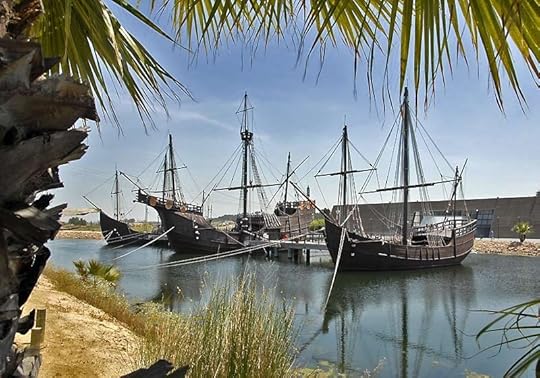Mike Jastrzebski's Blog, page 79
October 20, 2011
The WHOLE thing?
C.E. Grundler
[image error]
The whole hole. Think it'll leak?
I'm often amused by the reactions our work aboard Annabel Lee draws from onlookers and passers-by. Last weekend a fellow stuck his head into the shed, hoping to locate one of the mechanics and a set of jumper cables to fire up his Jet-Ski. He looked up at my husband and I, decked out in tyvek pjs, filtration masks and full-face eye protection, then he looked to the powertools in our hands and the massive opening where the salon ceiling once was and said, "You're fixing this boat? That WHOLE thing?" Another fellow once told me how he'd love a boat like ours, with all her character, though he didn't feel he was "brave enough for a project like that." But the comment I most frequently, and the one that amuses me the more than any, is how lucky my husband is.
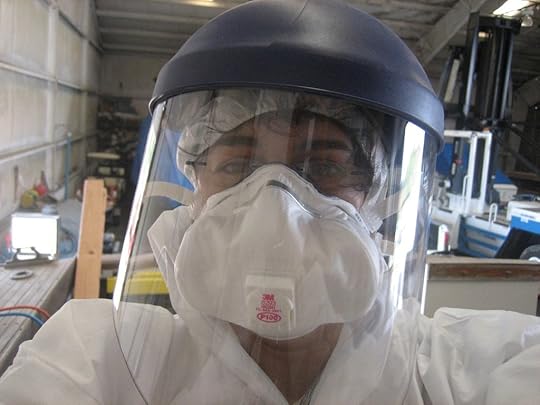
Me, looking my most glamorous!
If I had a nickel for each time I've heard that one… well, nickels don't go that far these days, but you get the idea. I'd look from our boat, which appears to have come through a missile-testing site, to my stylish apparel, and in truth, at first that statement used to baffle me. Apparently, it turns out people are under the impression that my husband has the most understanding and helpful spouse; after all, I'm always down there at the boat, working away. In fact, I'm down there more often than him. And around our yard, around the scary-project boat area at least, it's a man's world, one where women are few and far between. I never thought much of it, after all, compared to Christine and several other friends, I'm merely a weekend boater; an amateur by comparison. It still comes as a surprise to me that others find my presence odd.
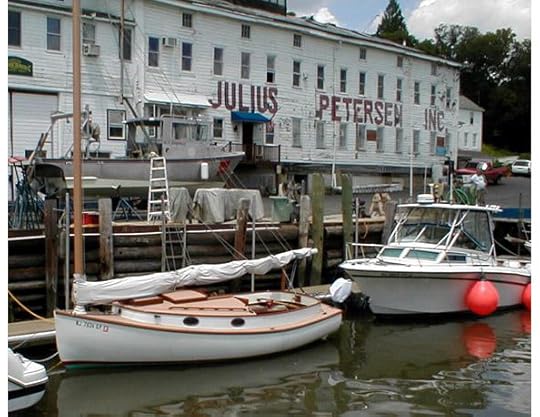
Myra Lee - MUCH less work!
Years ago, when I had my lovely little catboat, I heard some strange remarks as well. When I first bought her she was a bit rough around the edges, but each season I tackled more projects and as time went on she really began to shine. My husband didn't sail and I think in all the years I owned her, I had him aboard twice. But I recall walking down the dock one summer day to find an admirer gazing at her. He pointed to the boat and smiled, saying how much he would love to have a boat like that… but all that brightwork! He told me, "I heard some girl owns that boat." I nodded as I climbed aboard. "Some girl," I agreed. "Oh, it's yours? Who does all that work for you?" he asked. "Some girl who owns it," I replied. It's my boat. Who else would I have work on her? And when we first went to look at Annabel Lee, the broker immediately angled his conversation to my husband, who informed him, "Talk to her. She's the one buying this boat." She's the one who knows boats, not me."
Perhaps if it was just me alone, it might not seem so strange. But as a couple, the assumption is that it's the husband's insanity, and he has such a supportive, understanding wife. But in our case, it's the other way around. Yes, we work as a team and we're in it together. Truth is I'm the insane one, (which is the reason we named her Annabel Lee, as you Last Exit readers might have caught) and I have a wonderfully supportive, understanding husband, though people seem to think he's joking when he tells them, "This thing? It's her boat. The whole thing."
[image error]
Annabel Lee - A whole lot of work!
Share on Facebook
October 18, 2011
I am a Hemingway Hater

Makes me feel queasy even in digital form.
I am not going to make many friends this week as I have come to realise with some surprise that Ernest Hemingway is a hero of many at Write on the Water. As the title states, not only do I not care for him, but I actually dislike his novels including "The Sun Also Rises" and "Farewell to Arms." I agree his writing style is excellent, but his narratives are boring, dealing with stupid people doing trivial things. I have tried but cannot read them. Anyone who thinks otherwise lacks my incredibly sophisticated taste.
But putting aside how terrible Hemingway's books are, my distaste is a good example and lesson about differences of opinion about books. If I feel differently about such an apparently beloved author, how can I not expect some people not to like my blog. How can Michael Haskins not expect some people from disliking "Chasin' the Wind" or CE Grundler the "Last Exit" despite her word cuts?
Even further, I argue that writers should consider dislike and criticism as positive signs. If Hemingway was not something special, I would not care enough to try to read his novels and end up disliking them. And if he was not so well written, I could toss him aside as just another James Michener. Ouch! That's right. So, Tom Tripp, do not fear your critique group.
So now that I have hopefully offended everyone, what author(s) do you dislike that everyone else likes? Feel free to put on that list as I will take it as a complement. Or what do you dislike that most others like? I hate corn on the cob even more than I dislike Hemingway. Take that Mike Jastrzebski.
If you would like to take this to the next level, head over to my blog Waves. Today as on every Wednesday, I should have hopefully posted an article about the events leading up to the Fort Lauderdale International Boat Show including tonight's free "Boat Show Night Out."
Share on Facebook
October 17, 2011
Stepping (Gingerly) Into a Critique Group
by Tom Tripp
I realize I probably should have done this before now, but then again, I'm done with "should-ing" on myself, so it doesn't matter. I thought I would write about the process here on Write On The Water so others who might be lingering on the sidelines can see how it works (or doesn't).
Christine, Mike, Victoria and John on this blog are, I know, experienced critique-group members so I'm hoping they'll chime in with comments and suggestions. Anyway, here's what's happened so far for me.

Critique groups can meet anywhere, even in a spare office
Like many writers, I spend more than my share of time writing in coffee shops. My latest haunt is a little shop in Miller Place, NY, called "Bean Berry." As time goes by, I usually begin to recognize the other regulars and occasionally I've gotten to know some of them. At "the Bean," I met two reporters for a local community newspaper publisher. They had recently been forced into the virtual office environment when the publisher closed his physical office spaces.
To be honest, I didn't have a lot in comment with these young reporters, except a common experience in journalist, and, as it turns out, a wider passion for writing. Samantha, in particular, was spending some time working on short fiction as an outgrowth of some coursework she had done in college. She had actually interviewed me after Hurricane Irene blew through Long Island late last summer, as one of the "displaced" home-office workers who were populating local coffee shops in search of electricity and Internet connections.
After the interview she asked more about my writing work, which includes both freelance magazine/Internet writing and publishing, as well as work on my first mystery/thriller novel. One afternoon, Sam stopped by my "desk" at the Bean and asked if I had ever been a member of a critique group and I admitted, sheepishly, that I hadn't, despite many years of creative writing efforts. She said she was interested in creating one. I remembered Christine and Mike having talked here about some of what they got out of their group and I decided to take the plunge.
But Sam didn't have any idea how to create a group. She thought maybe we should put a notice up in the Bean and see if we could get a large group together. To me that sounded more like a group "reading" than a useful critique group. The scale of it scared me. Let's face it, sharing your best work with total strangers is quite a lot like getting naked in public. Seems better to start in the backyard than in Yankee Stadium.
We're still getting organized at this point and we only have three of us committed so far. I'm not sure what the ideal size is for starting out, but it feels like four or five might be good. Our plan is to start out by sharing one piece, or fragment each with the group and trying to tackle one or two per evening session. I guess we'll have to see how much time the process takes.
Our first meeting I hope will seek agreement on the specific goal(s) of our group. In my mind, the main goal is to get constructive feedback on our work from others who have no emotional attachment to the work but who are genuinely interested in helping contribute to our success.
If you've been a member of a critique group before, what worked for you and what didn't? Any suggestions for us as we begin to create a group from scratch?
Share on Facebook
October 16, 2011
From Rags to Riches: How to increase sales
Last week I wrote that my sales have been down the last couple of months. I'm not the only one with this problem, but I think I know the way to correct the problem. Write more books.
This is not something I've discovered on my own. Joe Konrath has written about this, as have several other e-book authors who sell well. I scoffed at this solution at first, after all, writing another book is a lot of work.
Instead, I tried posting about my books on facebook and advertising on GoodReads and blogs like The Kindle Nation. I saw some sales increases, but when my new book, Dog River Blues (A Wes Darling Mystery), came out last month I saw even more of an increase, especially for sales of  Key Lime Blues (A Wes Darling Mystery). I'm not talking big numbers, but a definite up-tick in sales.
Key Lime Blues (A Wes Darling Mystery). I'm not talking big numbers, but a definite up-tick in sales.
My new book, Weep No More, will be available next month. This book is a standalone and completely unlike the other books I've written. For one thing the protagonist is a woman. This is a dark thriller; here's the blurb:
For Linda Morgan, an investigator with the Minnesota Department of Health, murder is the last thing she expects to confront while pursuing a sexual misconduct complaint against an egotistical psychotherapist.
Just out of an abusive marriage to a charming alcoholic, Linda fills her life with work and volunteering at a local women's shelter. She has little time to dwell upon the lack of a man in her life.
But in the course of one fateful week, Linda's life is unexpectedly overflowing with men. She meets a guy who considers her someone special, her ex-husband returns and tries to seduce his way back into her life, and a stalker takes an obsessive interest in her affairs.
Surrounded by dead bodies and deceit, Linda is forced to answer a question that's haunted her since childhood. Who can she trust? The clock is ticking down and the wrong answer could kill her.
Will the release of this book result in another increase in sales? I don't know, but I do know I've got to try. I'll you know what the answer is in a couple of months.
In the meantime, I know I have to get started on the next book ASAP. The next book will be a Wes Darling Mystery and I hope to have that completed and ready to publish by the end of next summer.
Why so long? Because November, December and January I will be working on the boat. The plan is to get the next book written while sitting at anchor somewhere in the Bahamas. Looking at maybe Abaco Blues or West End Blues for a title. Let me know what you think.
Share on Facebook
October 13, 2011
Leaves of Change
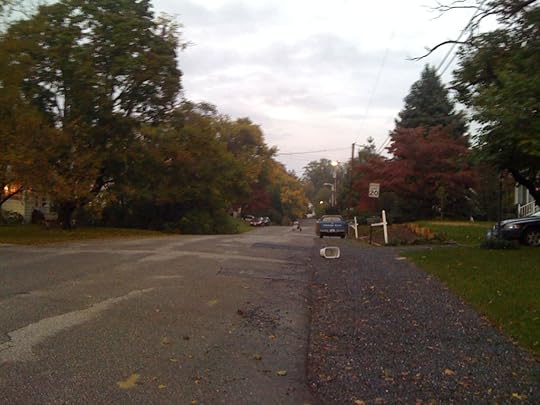 The leaves are starting to change colors here in Annapolis. I love it. You have no idea how amazing this is to a person who has only lived in Southern California, Hawaii, the U.S. Virgin Islands, and South Florida. This autumn leaves thing is all brand new to me.
The leaves are starting to change colors here in Annapolis. I love it. You have no idea how amazing this is to a person who has only lived in Southern California, Hawaii, the U.S. Virgin Islands, and South Florida. This autumn leaves thing is all brand new to me.
I am anchored out in Weems Creek still, just off the Severn River, and for the last two weeks I have been working for the company
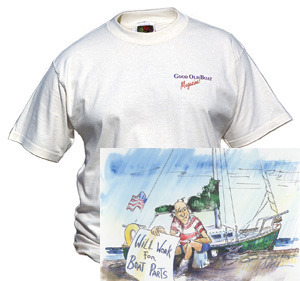
My favorite T-shirt from the Boat Show
that puts on the two boat shows here. We work 60 hour weeks for two and a half weeks in order to feed the cruising kitty. Most of the others on this itinerant labor force are also cruising sailors. We finished up the Sailboat Show on Monday, restructured the tents and displays and changed all the boats, and today the Powerboat Show opened.
Every morning I get up, suit up in my rain gear and sea boots and row Chip ashore in my dinghy in the dark. The dead end street where I beach the dinghy is at the base of a hill that is lined with tall leafy trees. I've been waiting and watching, hoping the leaves would change before I leave the area. This week the leaves have started to flutter down in the breeze and after the front that came through over the last couple of days that brought wind and rain, the streets are now covered with wet, dead leaves.
Unlike me, most Americans are used to this annual ritual of change.You would think watching the changing seasons would prepare them for change. But no, many are resisting it with all their might.
There were several authors with display booths at the show, and I stopped by one such booth on my break yesterday afternoon. We got around to discussing my plans to self-publish my new thriller.
"What are you going to sell it for?" she asked.
"I think $2.99 sounds like the sweet point price," I said.
"I resent that," she said. "It cheapens the value of a book for all of us."
When she said that, I remembered back to these long conversations I had with Mike Jastrzebski in the parking lot outside our critique group. Back then, I thought the same way this sailing author did. I wasn't yet able to change my thinking for the new paradigm of the world of independently published ebooks that allow authors to deliver their content directly to their readers. This process does away with all the middle men who needed to make something off this transaction in order to survive. You no longer need to put into the price the cost of paper or printers' ink or truck transport or storage or bookstores, etc. With most ebook publishers paying a royalty in the area of 70%, I can make the same money on my ebook as I would have on a hard cover priced above $20.00. Should I pass the savings on to the reader? I've finally come around to seeing the wisdom in that.
Mike, just like these autumn leaves, I, too, can change. Whenever I finish these edits (which are going very slowly with these long days of manual labor), I will self-publish CIRCLE OF BONES and price it at $2.99. Even I can change.
Fair winds!
Christine
Share on Facebook
Cuts…
C.E. Grundler
15,829. That's the final count for words cut from Last Exit, though these were not wholesale chops so much as fine-tuning every sentence from beginning to end. (Less circular saw and more Dremel.) Yes, a few minor elements were trimmed away, but they were mere paragraphs here and there, mostly non-essential darlings like those random black Jettas. But those cuts are over and done with, only to be eclipsed by far scarier ones involving large power tools, dreadful noise and vast amounts of fiberglass dust. Yes, we've begun the attack on the salon ceiling/bridge deck.
[image error]
As with writing, there are certain things that go hand in hand with owning an old boat. A certain sense of adventure, I suppose. Optimism is helpful as well. Determination. Perseverance. This repair has been a long time coming. From what I'd been told, Annabel Lee's former owner was very fond of his power sander. Evidence is all around the boat, where teak has been sanded clear down to the fasteners in many places. Decks that had once been 1/2″ thick were reduced to 1/4″ or less. Of course, we're only too aware that the upper helm had more than once leaked, and in lowest spots of the bridge, (made even lower by years of zealous oversanding) the fluid ate through the bedding, followed the screws into the coring, and eventually into the cabin. Leaks, leaks and more leaks. Fortunately, our little boat has a certain unusual, exceptionally rare feature. ALL her coring, in fact all wood used in her construction, be it structural, joinery or cosmetic, is TEAK. Aside from the engine and the concrete in the ballast, if it's not fiberglass, it's teak. And the teak we've found is indeed wet, but as solid as the day the boat was built. Unfortunately large areas of the glass above and below had completely delaminated, flattening out and sinking in the process.
[image error]
We evaluated the merit of repairing from above and below, and, after much consideration concluded the best way to do this properly would be the most drastic. We would cut away the damaged section and replace it with a new core of marine ply laminated together with epoxy resin, supported by stringers that duplicate the originals and glassed in from above and below shaped to the exact camber as the undamaged areas of the cabin. We built a frame to duplicate the actual dimensions and shape, and laminated the wood in our garage.

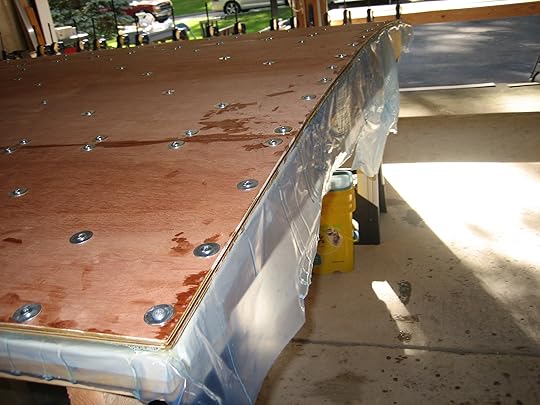
We'll truck this down to the boatyard, where it will be lifted by the Wiggins forklift to the proper height and guided into place. It should be interesting. But as of last weekend, we covered every inch of cabin with plastic to hopefully control the impending mess, and made that first terrifying cut. The cabin now sports one very weird sunroof. This is just the start, but as which so much else in my life at the moment, there's no turning back now.
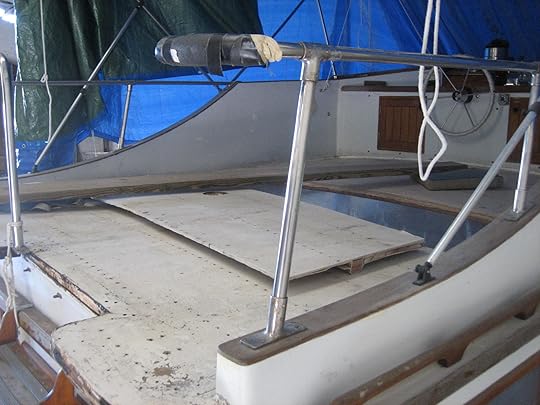
Share on Facebook
October 11, 2011
A Tip of the Hat to Columbus
Columbus Day, a holiday that holds a special place in the hearts of the Write On The Water crowd.
In some parts of our country, people have attempted to reduce Columbus' place in history. Some of this stems from trivial stuff such as the footnote that indigenous people already lived here when Columbus discovered America. Or muddying things up by pointing out that Leif Ericson and his Norse companions ventured over to these parts centuries before the Nina, Pinta, and Santa Maria set sail.
Don't fall for this, I say. Hold fast to the indisputable truth that our man Columbus sailed the seas more than five hundred years ago, explored new lands, and changed world affairs. And in any case, take a moment to consider the magnitude of this heroic feat. If you can, consider an Atlantic ocean crossing in 1492, a time when:
Cellphone and WiFi coverage was horrendous;
Sperry docksiders had leather soles and looked like dingo boots; and
GPS and electronic chart plotters generated maps that depicted the world as being flat.
Sure, Columbus could cross the ocean without worrying about getting run-down at night by supertankers screaming along in the commercial shipping lanes. And granted, he didn't have to worry about ethanol screwing up his fuel lines. On top of that, okay, he had all the good anchorages when he entered uncongested harbors.
But as sailors, we know the truth: the man from Genoa must have been one hell of a seaman. And as writers, we know something else: Had he lived in our times he would have landed one heck of a book deal. So let us all at Write On the Water tip our caps to Chritoforo Columbo, Mariner of Genoa.
And Chris, thanks, too, for the convenient holiday that lands just before the end of the sailing season up here in New England.
Share on Facebook
October 10, 2011
Sun, Sand and Suspense
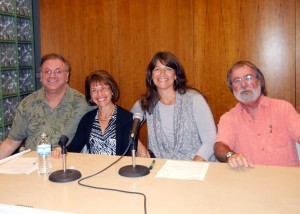
Neil, Sharon, Julie & Michael
Last week I had the privilege of being on a mystery writer's panel at the Broward County Main Library, 100 S. Andrews Ave., in Fort Lauderdale. It was part of the library's Mystery and Crime Fiction in Florida 1895 – 2011 display.
I was on a panel – Flagrantly Floridian – with MWA members Julie Compton and Sharon Potts. Our moderator was Neil Plakcy, president of the Florida chapter of Mystery Writers of American. We talked about why we wrote about Florida – Key West for me – and how our coming from outside Florida affected our concept of the state and was that good or bad.
If you have a chance, stop by the library and see the exhibit on the sixth floor. It contains books by some of the best mystery writers in Florida and portrays Florida as a state through its mystery writers – especially Miami.
Tonight, Oct. 11, 6:30 p.m. the second panel in the series features Nancy J. Cohen, Elaine Viets and Deborah Sharp. All three of these fine writers have a different take on crime in Florida, so the conversation, again led by Neil, should be colorful. The panel is Three Dangerous Dames. Appropriately named. I know all three women and you won't be disappointed if you take the time to stop by.
It is also good to support a library, wherever you live. With budget cuts facing so many local, county and state governments, libraries seem to be on the line everywhere. Add to that the eBook revolution and they may soon become a thing of the past; at least how we consider libraries as a refuge with books.
Share on Facebook
October 9, 2011
Remembering Mobile
By Mike Jastrzebski
This weekend the weather cooled in Ft. Lauderdale, the wind rocked the boat for about twenty hours, and it rained, hard and steady for hours at a time. It brought back fond memories of our time in Mobile, Al.
I wrote about Mobile in my last book, Dog River Blues (A Wes Darling Mystery), and I spent the last year working on that book so maybe it wasn't entirely the weather that had me feeling nostalgic, but it sparked the memories.
We formed a lot of friendships in Mobile, and we had our first contact with tropical storms.  Notice the high water on the docks in the following picture.
Notice the high water on the docks in the following picture.
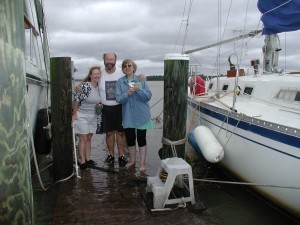
Now don't get me wrong. I don't want to go back to Mobile, and I'd like to avoid as many storms as possible. As I write this I realize it's not so much a feeling of nostalgia, but the thrill I feel at the idea of getting away from the dock and heading off on another adventure.
I've said it before and I'll say it again–it's time for us to leave this place. The boat was built for sailing, not sitting at a dock. Of course, if we hadn't sat here at the dock I wouldn't have three books published with the fourth nearing completion.
Such is life–there are always trade-offs.
Share on Facebook
October 8, 2011
Introducing our newest contributor, Wally Moran
My life on a sailboat happened because of a lawyer. Without going into details, this lawyer doing what litigation lawyers do made my life so unpleasant that I was open to alternate lifestyles. The one I was living wasn't so much fun anymore. Something had to change.
I had my 7.4 metre sloop Publisher's Choice docked at Dutchman's Cove in Georgian Bay in Lake Huron. Dropping by the marina mid-January, I ran into old friends who kept their 37 Irwin there.
They planned to retire to the Caribbean, and we discussed that for quite some time. I read e-mails from another couple already in the Caribbean on their Morgan 41.
Little did I know a seed had been planted that would see its fruition only when I had totally changed my life. I reread sailing magazines for evidence that people actually lived and cruised on boats and soon decided I liked the idea – what's not to like?
I had contemplated cruising previously. In my early twenties, one of my closest friends wanted to buy a boat for charters. We looked at a decrepit wooden trimaran, planning its refurbishment. We would have had the perfect boat for our plans and at the perfect time too, as chartering was just then catching on.
In my thirties, a lady I dated wanted to buy a boat and charter it together in the south Pacific. I passed, not being as enamoured of the lady as she was of me.
Now I needed to seriously consider the dream, as it arose this time from my own soul.
Never having been a saver, there was no kitty available for a sailing lifestyle. I needed to save a lot of money. I would need to purchase - with apologies to Publisher's Choice – a larger, more seaworthy boat. I would need funds to live on and, eventually, retire on.
I was in the newspaper business so the answer seemed simple. Establish a sailing publication, build it up, sell it out in five years. Then go. That I could do this I had little doubt. Find (or create) a need, then fill it.
That this plan never had a prayer of working was actually how things ended up.
My website's mainstay was book reviews. This entailed contacting marine publishers for review copies. My intent was twofold.
One was to create an interesting knowledge base for the site. The other, to educate myself about sailing using these books as my texts, the authors as my professors, my fellow sailors as mentors. I was embarking on the equivalent of a four year university course, the graduation ceremonies consisting of casting off the lines and sailing to a new life. Isn't that a wonderful metaphor for a graduation?
My library soon comprised sailing's best known authors: Adlard Cole's Heavy Weather Sailing, Cornell's World Cruising Routes, Hinckley's Guide to Yacht Care, John Vigor, Don Casey, Dan Spurr, Nigel Calder – they and more were represented.
The books that captured my attention were the books on cruising. The Pardeys, Smeetons, Liz Copeland, Martin Hederich, Gerry Heuting (who founded Dutchman's Cove), Tom Neale and others…they'd been there, done it. Some were still doing it.
I wanted, needed, to read what they said. Their books became my textbooks, they the teachers who inspired me.
They whispered into my ears, their lives crept into my dreams, they beckoned from their boats as I chased after their sterns.
I noticed something strange. They weren't writing to tell us about their adventures, their fabulous lifestyle. They were inviting us to join them, if we would.
"Go!" they said. "Go!", and as they became good and familiar friends, their "Go!"' became 'come', their hands reaching out to grasp mine as I leapt aboard.
To sailors, this discovery is no surprise. For those who are not, you will learn if you become a sailor that the fraternity welcomes all who care to join them and that the camaraderie of the sea is alive and well, even on the smallest inland lake.
Now, a boating writer myself, I find myself saying "Go!" as I reach out to others reading my words.
'Go!'
Wally sails his Dufour 34, Gypsy Wind, between the Great Lakes and the Caribbean, including Cuba. He writes for SAIL and Waterway Guide, creates sailing videos and lectures at various boat shows…when he's not pinching himself while wondering if he's dreaming.
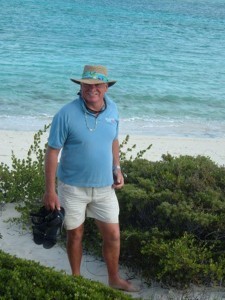
Share on Facebook


